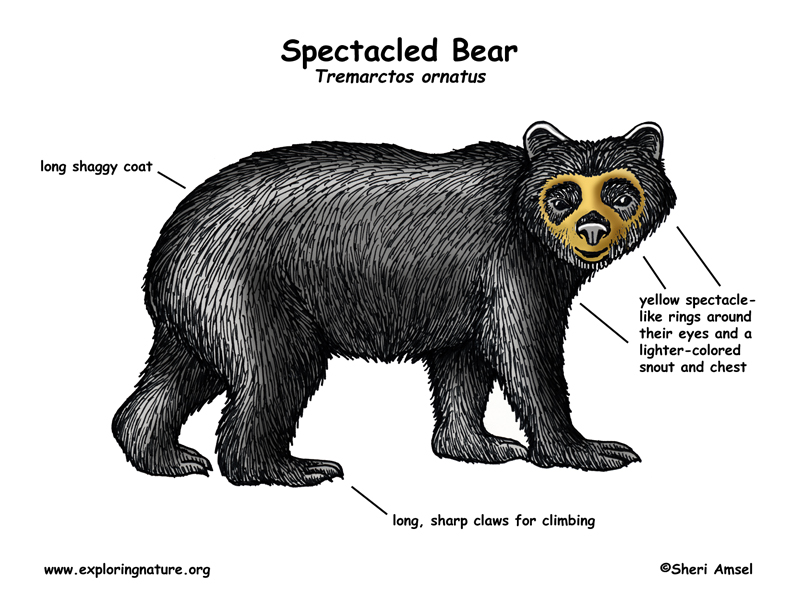

They live in South America and are the only bear species on that continent.
They live in the Andes Mountains in dense forests, both rainforest and temperate, and even in dry scrublands.
They are small brownish-black bears with a long shaggy coat. They have yellow spectacle-like rings around their eyes and a lighter-colored snout and chest. They can weigh more than 300 pounds (135 kg) and reach 6 feet (1.8m) long but are usually smaller. Females are much smaller. They have long, sharp claws for climbing.
They are active at night (nocturnal) and in early morning and late evening (crepuscular). They are great tree climbers and spend a lot of time in the trees searching for and feeding on fruits. Because they can find food year round, they do not hibernate. During daylight hours, they sleep under tree roots or in a cave den.
Though they are classified as carnivores, they eat mainly fruit, cacti, honey and even tree bark. They also prey on small animals – rodents, birds and insects. They may kill livestock.
There only real predator is man.
Females are pregnant for about 8 months (gestation) and usually have 2 cubs. She will nurse them for about 7 months at which time they can go out on their own. This is relatively young for a bear cub to be independent. Spectacled bear, as with most bear species, have delayed implantation. This means that though they mate in the spring, the fertilized egg(s) maybe not start to grow until later so the cubs are not born until there is better chance that there will be food for them.
Unknown in the wild, though in captivity they have lived for 25 years or more. They are listed as Vulnerable on the IUCN Red List.
Kingdom: Animalia
Phylum: Chordata
Subphylum: Vertebrata
Class: Mammalia
Order: Carnivora
Suborder: Caniformia
Family: Ursidae
Genus: Tremarctos
Species: T. ornatus
When you research information you must cite the reference. Citing for websites is different from citing from books, magazines and periodicals. The style of citing shown here is from the MLA Style Citations (Modern Language Association).
When citing a WEBSITE the general format is as follows.
Author Last Name, First Name(s). "Title: Subtitle of Part of Web Page, if appropriate." Title: Subtitle: Section of Page if appropriate. Sponsoring/Publishing Agency, If Given. Additional significant descriptive information. Date of Electronic Publication or other Date, such as Last Updated. Day Month Year of access < URL >.
Amsel, Sheri. "Bear (Spectacled)" Exploring Nature Educational Resource ©2005-2024. December 14, 2024
< http://www.exploringnature.org/db/view/Bear-Spectacled >

